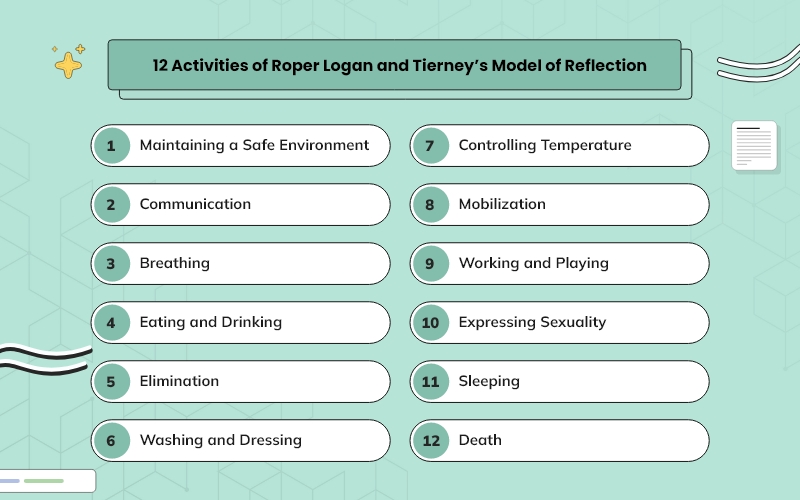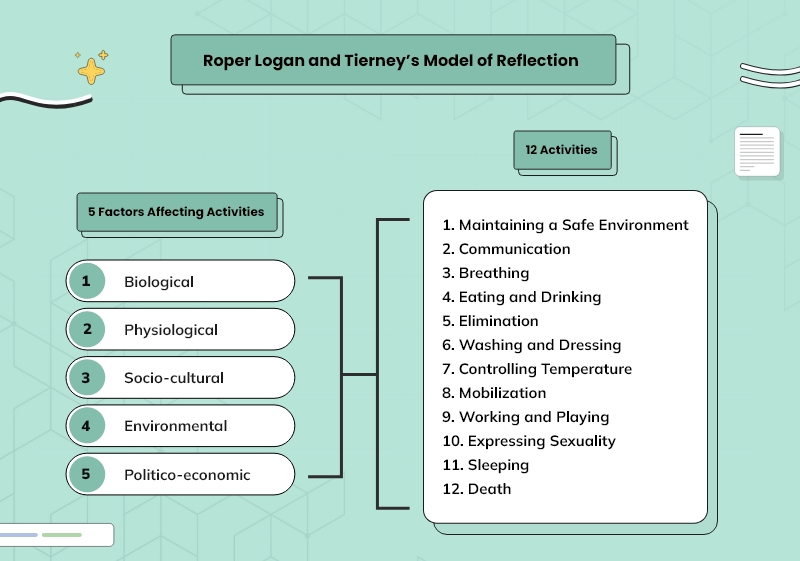
Overview
With the intention of providing an assessment plan to the nurses for determining the dependence and independence of patients in the hospital, Roper Logan and Tierney's Model of Reflection was created. This model was developed in the year 1980 and was named after the author of the model of reflection, Nancy Roper, Winifred W. Logan, and Alison J. Tierney.
Table of Contents
12 Activities of Roper Logan and Tierney’s model of reflection
Through the model, the author proposed 12 activities of daily living that state.
- Maintaining a safe environment
- Communication
- Breathing
- Eating and drinking
- Elimination
- Washing and dressing
- Controlling temperature
- Mobilization
- Working and playing
- Expressing sexuality
- Sleeping
- Death
These 12 activities will act like an action plan for nurses that take care of the patients in the hospital. These factors will assist the nurses in checking the dependency or independence of the patient over the hospital. Moreover, these action plans would also assist hospitals in analyzing the progress report of the patient from time to time. This will not only assist in keeping track of the patient’s performance but will also assist in measuring the performance of your key performance indicators.
Moving ahead, Logan also stated that all the above-stated activities are majorly influenced by 5 major factors. He stated that if these mentioned factors are not taken into consideration, they might result in biased or not well-informed results. The 5 factors stated by Roper Logan and Tierney's model of reflection are
Five Factors affecting 12 activities
1. Biological
The biological factors consist of the overall condition of the patient. To elaborate, it includes the information about the medical condition of the patient before they contacted the hospital for the diagnosis. This factor is important because based on the biological condition of the patient, you will be able to make a well-informed decision about the treatment and medication.
2. Physiological
As per Roper Logan, this section is all about “knowing, thinking, hoping, feeling, and believing.” This implies that this section will cover all the emotional contexts of the patient that will impact the further treatment in one way or another.

3. Socio-cultural
The impact of the culture and society on the patient will be under the category of social culture factor that impacts the result of the overall action plan. This section is related to the cultural beliefs, values, and traditions that affect the patients in some possible way.
4. Environmental
This impacting factor deals with the environmental impact on the activities that will be carried out with the patient. This states that a change in environment or unfavorable environment can impact the overall performance or progress of the patient.
5. Politico-economic
Last but not least come different politico-economic factors that might impact the activities. This can include various factors such as the state of war within the country, funding policies or schemes launched by the government, or additional economical benefits due to health insurance.
After having a clear understanding of the model, it is now time to look at the example of reflective writing that will assist you in better comprehension of the reflection practice using Roper Logan and Tierney's model of reflection.
Roper Logan and Tierney model example in nursing
Case assessment - This example will highlight the experience of a third year nursing student assessing a patient named Jonah suffering from Post Traumatic Stress Disorder. The reflection example will focus on the nursing assessment of Jonah done by a nurse through a checklist.
I am a third-year nurse student and I have been working with the hospital for almost two years. Recently Jonah joined us. Jonah has basically been a drug addict who tried to leave drugs behind in his life but now he has been diagnosed with Post Traumatic Stress Disorder (PTSD). Posttraumatic stress disorder (PTSD) is commonly associated with type 2 diabetes mellitus (T2D) (Roberts et al., 2015). Jonah also is a patient with diabetes who currently has a blood glucose level of 450 mg/dL which is way too high for the ideal level of blood glucose. Currently, his diabetes is controlled using insulin injections twice a day with 3 to 4 other medications. Jonah is currently in a safe environment but sometimes due to his PTSD, he reacts a little anxiously and tries to harm others. This is the reason he is kept in a single-room ward with no harmful objects near him.(Note - In this, you can see a biological factor affecting the environment of the patient.) Jonah speaks British English and I have been an American native my whole life. So, there always remains a little accent and communication problems. Moreover, due to PTSD, sometimes, my mind of Jonah takes time to process things and understand the actual meaning of my message. (Note - Here you can see how being from a different culture made a difference in the communication of the patient and the nurse. This highlights the socio-cultural factor impacting the communication activity of the model.) Because of too much glucose, the lungs of the diabetic patient function at a slower pace which might result in shortness of breath. This is the reason sometimes Jonah also faces the issue of breathing, and once a week I need to give Jonah the support of external breathing through oxygen masks. The eating and drinking habits of Jonah have been stable lately but when he came, he denied eating or drinking anything at the hospital. The reason is that PTSD made Jonah believe that everything he eats or drinks is made of drugs and he will die as soon as he eats any food. But, then the psychologist of the hospital convinced Jonah that the right food will make him healthy and strong to fight drugs. Since then, the eating habits of Jonah have been stable. (Note - The physiological factor affects the drinking and eating behavior of the patient in a negative way.) Elimination in this model refers to this private activity in which the patients get rid of body waste. Jonah has never been dependent on the hospital for the elimination activity. Jonah sometimes gets stubborn during the washing and dressing. That's the reason, I sometimes need the help of other nurses to get him dressed and washed up clean. PTSD can release cytokines and prostaglandins through white blood cells which might result in temperature rise from time to time (Kany et al., 2019). This is the reason I feel Jonah's temperature is not under control. Moreover, the place where Jonah sleeps is kind of cold but due to Jonah's frequent occurrences of self-harm, we have not been allowed to keep a heater in his room. (Note - The environmental factors and biological factors cause a change in the activity of controlling the temperature of the patient.) There was no issue with the mobilization of Jonah, this implies that Jonah was in no way dependent on the hospital for his mobilization.Due to PTSD, Jonah was tired from time to time and that was the reason he never got indulged in any sort of working or playing around much. Besides, PTSD was causing him stress, so he never really played around with other patients as well. The medication and treatment of the patient do not have anything to do with expressing sexuality. So, track of this activity will not be kept by the hospital in any possible way. After viewing his last week’s record and this week, I compared Jonah's not being able to sleep properly and the main reason was that his PTSD made him wake up every 15 minutes. This made it difficult for him to sleep at night. This also caused him to be tired during the day. Keeping Jonah in proper care for over 6 to 7 months and giving him proper medication, there are no signs of early death as of now. This shows that proper treatment and care can lead to Jonah's long and healthy life.
FAQs
Limitations of Roper Logan & Tierney's Model of Reflection?
The limitations of the RLT model of reflection may include oversimplification as this model aims to simplify the complexity of patient care, some patients may have more complex health problems that might not fit into the model categories. Additionally, it is relatively fixed so any rapid or unexpected changes in patient health might become challenging for you to tackle.
How does the model promote a holistic approach to patient care?
By considering the ADLs and the five influencing factors, the model takes into account the patient's physical, emotional, cultural, environmental, and socio-economic contexts, ensuring a comprehensive assessment of their needs.
Previous Model
CARL framework of reflectionNext Model
5R famework of reflectionReferences
Kany, S., Vollrath, J.T. and Relja, B. (2019) “Cytokines in inflammatory disease,” International Journal of Molecular Sciences, 20(23), p. 6008. Available at: https://doi.org/10.3390/ijms20236008.
Roberts, A., Agnew-Blais, J., Spiegelman, D., Kubzansky, L., Mason, S., & Galea, S. et al. (2015). Posttraumatic Stress Disorder and Incidence of Type 2 Diabetes Mellitus in a Sample of Women. JAMA Psychiatry, 72(3), 203. doi: 10.1001/jamapsychiatry.2014.2632

 Proof Reading
Proof Reading  Copy Writing
Copy Writing  Resume Writing
Resume Writing  Blogs
Blogs Guides
Guides SOP's
SOP's Student Resources
Student Resources Research Topics
Research Topics Login
Login Register
Register